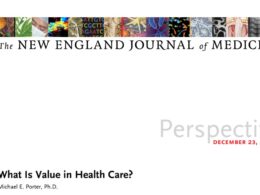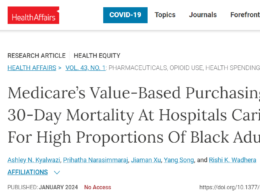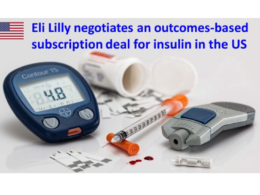Site editor:
Joaquim Cardoso MSc.
Health Transformation — institute for research and strategy
October 6, 2022
This is an excerpt of the article “Mortality Rates for Medicare Advantage Are Actually Significantly Lower and Better, with Fewer Deaths ”, with the title above, focusing on the topic in question.
Intergroup Institute
George C. Halvorson
September 30, 2022
We need to understand that the payment model has a major impact on whether or not our patients get the right care.
Medicare Advantage plans are paid by the month for each patient and not paid by the piece for each piece of care, so Medicare Advantage plans do the basic work to keep people from going blind and to keep people from losing limbs to amputation and the plans can do that as a regular outcome because the capitation payment gives plans the resources to do that work and then the capitation cash flow rewards them financially when the care is successful and the amputation isn’t needed.
… the capitation payment gives plans the resources to do that work and then the capitation cash flow rewards them financially when the care is successful and the amputation isn’t needed.
The fee-for-service Medicare care sites currently make $100,000 on each amputation and the fee-for-service Medicare sites in total bill for $8 billion in amputations each year.
The care provided in the amputation situations can be extremely difficult and it is inherently dangerous and it should not happen if we are giving Medicare patients the right care.
High mortality rates happen for that surgery.
That is very wrong in almost all of those care sites in terms of patterns of care before the amputation happen.
Medicare Advantage goes down a very different path for patients and members.
The Medicare Advantage plans all know that 90 percent of those amputations started with ulcers on the feet of the patients. They all know that 90 percent of the ulcers on patients’ feet could have been either prevented or cured.
Simply having patients wearing clean socks and having dry feet can stop over 40 percent of those ulcers.
Medicare Advantage plans all have care teams helping patients to have dry feet and fee-for-service …
… Medicare care sites for low-income people usually have no one doing that work and those care sites just let those ulcers turn into amputations and then, far too often, into death.
Those processes are why the mortality rate is so high in fee-for-service Medicare, with upwards of 40 percent of those patients dying …
…and it’s why the Medicare Advantage special needs plans who take care of those low-income people who have personal eligibility for Medicaid as well as for Medicare, were shown on the new dual process report to only have a total death rate as a program of 2.72 percent.
… fee-for-service Medicare, has upwards of 40 percent of those patients dying …while Medicare Advantage special needs plans… only have a total death rate as a program of 2.72 percent.
Doing the right thing actually isn’t hard a very large percentage of the time, but there needs to be someone in the care loop actually doing the right thing or it will not happen and that right person and that care loop does not exist for most low-income people in fee-for-service Medicare.
Doing the right thing actually isn’t hard a very large percentage of the time, but there needs to be someone in the care loop actually doing the right thing …
The differences are painfully obvious to anyone who just looks at those programs.
We need the hardcore Medicare Advantage critics to take that look and to explain to us all why so many of them continue to inexplicably be hardcore critics of Medicare Advantage plans who continue to urge hurting that care process and program in multiple ways.
MedPac continues to ignore all of the differences in outcomes and in care processes and managed to do another report where they said their key concern about Medicare Advantage dealt with the accuracy of the diagnosis codes for some of plans.
They should be using their great influence to get more people into Medicare Advantage special needs plans to keep them from going blind and dying..
We need everyone looking at the Medicare program and agenda for America to appreciate that there is a huge differences in care that happens immediately for many of our lowest income Medicare members when they join Medicare Advantage plans.
Patients with chronic conditions do particularly well when they are in Plans because each member has their own link to the care delivery network of each plan.

The basic care delivery model for Medicare Advantage is based on doing the right things to improve care.
The major epidemic of blindness going on for our senior Americans in too many sites today can be dealt with by managing the blood sugar for diabetic patients.
The capitation payment creates the resources needed to do that work and then the capitation cash flow rewards plans when patients do not have expensive vision loss.
Just like the amputation intervention process, the Medicare Advantage plans all know that you can avoid hospital admissions for congestive health failure patients by identifying all of the people at risk for a congestive heart failure crisis and then interacting directly with each patient to keep those crisis from happening.
The admissions for CHF cost $20,000 to $40,000 each, and when the care team intervenes very early in each crisis, usually almost half of them don’t happen.
Plans often assign nurses directly to each patient and some even put easy to use scales in the home because the easiest detection tool for a crisis is often significant and rapid weight gain by the patient.
Some plans even put scales in people’s homes that have telephone links to alert the care team when the weight gain for a patient happens.
Congestive heart failure crises are painful and often frightening and they can be both damaging and fatal.

Similar programs have similar positive impact on reducing asthma attacks for a number of patients.
Those attacks can also be painful and frightening and the right set of training and tools in place can keep most of them from happening.
Medicare Advantage plans tend to have about 35 percent lower use of emergency rooms as the result of all of those care improvement approaches.
Some of the MedPac people actually say that the 35 percent lower emergency room use by Medicare Advantage patients is an actuarial risk selection phenomena that has happened each year for more than a decade because, they say, people who are less likely to use emergency rooms also tend to enroll in Medicare Advantage plans.
That isn’t a good or legitimate way of understanding that number, but the MedPac explainers use it every year to show that the differences in care patterns for each patient mean that the plans are overpaid.
That’s the basis for one of the urban myths about Medicare Advantage payment rates that we need to stop using, because it is so clearly flawed.
Medicare Advantage delivers better care at multiple levels for the standard members and it delivers sometimes amazing care the people enrolled in the special needs plans who make up a major portion of that new report.
Medicare Advantage delivers better care at multiple levels for the standard members and it delivers sometimes amazing care the people enrolled in the special needs plans who make up a major portion of that new report.
Those programs for the amputations and blindness for standard Medicare Advantage work extremely well and they deserve recognition and support on their own, but they are far overshadowed by an amazing set of patient specific care processes that have been put in place as the full array of support needs for the special needs patients and for the low-income and high medical need patients who are enrolled in the Medicare Advantage special needs plans.
You can read about the performance data in this new Dual Eligible report that is giving us a new grounding for our assessment of the plans. They aren’t secret about what they do and why they do it.

Some of the best care in America right now is being given to Medicare Advantage Special Needs Patients.
The people who accuse Medicare Advantage of exaggerating the health care needs of their patients should be ashamed of themselves for distorting the truth so significantly and badly about those issues. People with some of the highest health care needs in America are in those plans and those patients are getting great care and also giving extremely high levels of satisfaction as members in the annual surveys.
So now we have a report that shows the cost of care for each of those programs and it shows the number of people who die going down each of those care trajectories.

Continuously Improving Care Happens When the Program is Set Up with that Goal in Mind
The other three programs in the study are the key versions of Medicare Advantage — Regular Medicare Advantage, and two kinds of dual eligible members that have special medical needs and who coordinate care and funding with the Medicaid program for the country and who are set up to having their care patterns continuously improve.
We have been focused in multiple recent polity discussions on the dual eligible population because their future is important to the country and it is good to have data about their care.
Each of the programs saves lives and money and each has its target population and patient focus that we need to understand. The Medicare Advantage Special Needs Plans have their own value that we need to appreciate more completely.
Each of those programs now has years of experience in coordinating the care needs of the members and each has continuously improving levels of performance.
We actually can both assume and know that the performance in those programs today is better than the day that data for the macro report was collected, because Medicare Advantage is the only major component of health care in the country that is on a continuous improvement approach and strategy through the Five-Star quality improvement program — and the outcomes in each of the programs continuously improve as a result of that process.
The quality agenda for Medicare Advantage has become an American performance norm, icon, and new achievement expectation, because plans everywhere use that five-star recognition system for both functional structure and cultural alignment and for triggering staff celebrations and morale enhancement when achievements happen.
It is now a mark of pride in multiple settings to achieve five-star status as a plan and care system and it’s clearly focusing for both staff and patients to have that status recognized.
As the planners who put the system together had hoped, the plans and care teams have created a sense of identity and pride for achieving high quality and service ratings.
The plans have created a culture and a strategy of continuous improvement as an overall approach because care is measured in a number of areas and that process helps create both priorities and activities for care settings.
In many settings, plans and care teams take great pride in achieving higher star ratings and improving care in key areas.
Americans like to be winners. Having multiple stars is clearly a winning thing to do. There is almost nothing else in health care in this country that sets up that opportunity to win and then is also such a legitimate sense of accomplishment that people on care teams can find it reinforcing as team members and as caregivers to get that recognition.

We know that even during Covid, the blood sugar measurements for diabetic patients that is so important for multiple diabetic issues improved in the plans.
It’s important to recognize that nothing else in health care in America today is working on continuously improving care in a systematic way that is changing the culture and the processes of care with that much impact and obvious success, and several studies have shown that care improvements in Medicare Advantage spill over to other patients in a care site.
It’s important to recognize that nothing else in health care in America today is working on continuously improving care in a systematic way that is changing the culture and the processes of care with that much impact and obvious success, …
… and several studies have shown that care improvements in Medicare Advantage spill over to other patients in a care site.
We know from the study on “Dual Eligible Beneficiaries” from the anchor U.S. Department of Health and Human Services study reflected that success because they mathematically counted much lower levels of those amputation deaths as part of their scorekeeping for showing the success of the plans and that’s why the death rate for the dual eligibles was only 2.72 percent.
The plan success and approaches that to provide better care to these troubled and damaged patients are a major reason why the mortality rate for the D-SNAP Medicare Advantage special needs program was only 2.72 percent in the dual outcomes research.
We are fortunate to have that information. That Dual Outcomes research piece is a wonderful and grounding report. It should give us a new priority and topic as a country on future reporting and it created an unexpected new topic that we will probably want to continue to use.
Mortality levels are very good to know and now that we know them, we should continue to report them.
We should actually ask CMS to include Mortality data on all of their relevant care performance reports from this point forward as a matter of course when the data is available and relevant to the topic and to remind us that we have choices in many of those areas.
We should also learn from that data in this report that we could have saved lives and limbs if we just had those people enrolled in Special Needs Plans.
We should clearly do what we can in every community in America to enroll every dual eligible person in a Medicare Advantage special needs program so that they are much less likely to die from the bad care that exists far too often for fee-for-service Medicare.
We need our news media to have the insight to step up the plate and look at the data and the processes of the Medicare Advantage program both to see for what it really is and to get that information out to people who need it so they don’t lose vision this year.
Better care clearly saves lives and the four levels of better care available in the Medicare Advantage program and measured by the government in this new study give us four levels of success for how long people live with each of the approaches.
Better care clearly saves lives and the four levels of better care available in the Medicare Advantage program and measured by the government in this new study give us four levels of success for how long people live with each of the approaches.
All of the plans work constantly to improve their processes and performance in those areas, so we know that they are all doing better now than they were doing when the government did that report, and we know that we would now save even more lives if we did that repeat of that study.

Three States Were Left Out of the Report Because They Had Too Few Deaths
Maybe the more interesting and most unexpected data point and reporting anomaly that we saw from that national mortality and plan performance report was the fact that care in three states that have a very long record of success with Medicare Advantage programs and with other community supported care improvement programs — California, Oregon, and Utah — actually had their mortality data excluded from the final report because all three of those states had mortality rates for the year that was less than 1 percent.
The people writing the report for the Department of Health and Human Services chose to not include what appears to be extremely successful data from those states that they did not understand and could not explain from those Medicare Advantage programs in their calculations. The authors of the report didn’t want to mislead or confuse anyone with data they could not explain.
That’s an okay and acceptable short-term decision to exclude that data about very few deaths for the purpose of this report — but we now need someone in the process to look at those numbers and to see what’s real and accurate today for all of those performance levels, outcomes and areas because the continuum of care might have some unexpected learnings for us all that would benefit a number of people.

The overall macro report is a very good report to do and to have.
It now includes some real data about death that we should probably be considering as a report topic for a number of reports. The mortality rates for that particular HHS report are not the usual estimates, approximations, or formulas of some kind. They are actual deaths. The researchers counted actual deaths from the Federal Medicare Data to come up with those numbers and real people died in each of those settings.
The overall report gives us great context data about the Medicare Advantage plans. We have some significant and hard core Medicare Advantage critics who are continuing to attack Medicare Advantage plans with highly theorized, very politicized, logistically dysfunctional, sometimes non-sensical, often emotional, inconsistent, generally extremely unmeasured and usually clearly unquantified, urban legend based, and almost completely data-free and vaguely historical criticisms of the actual functioning Medicare Advantage program — we know when we look at actual data about what Medicare Advantage actually does for people, that having caregivers assigned to patients who need care is an extremely good thing to do, and it should be encouraged because we have terrible mortality rates for too many seniors when we don’t get the seniors into Medicare Advantage plans.
We now know that the that actual death rate drops along with the number of amputations when we have Medicare Advantage care in place for those people and have the plans delivering the care.

Covid has been a particularly good example of the differences between the two approaches that came up with similar numbers.
The death rate for Medicare Advantage patients hospitalized with Covid was 15 percent, and that contrasted with a 22 percent death rate for the fee-for-service Medicare patients.
The death rate for Medicare Advantage patients hospitalized with Covid was 15 percent, and that contrasted with a 22 percent death rate for the fee-for-service Medicare patients.
The plans all have caregivers who are accountable for the Covid care of their patients, and the plans provided a direct set of caregivers and instant care when patients came in to care for the disease. Fee-for-service Medicare clearly and intentionally had no Covid strategy or organized response to the disease and each patient in fee-for-service Medicare had to figure out their own pathway to care when that disease hit.
Two of the largest Medicare Advantage plans were among the first care sites in America to respond with Covid supplies provided to their care sites, …
… and both organizations distributed testing capabilities to thousands of their caregivers well ahead of the national levels of performance in those areas.

What Will It Cost to Have More Survivors? [excerpted]
The new mortality data that we might have for Medicare if we get more people enrolled in plans actually creates its own set of issues at another interesting level.
One interesting challenge that our health economists, our government programs, and our politicians need to think about is, if we do succeed in what our ethical obligation should be, and if we do enroll twice as many people in our Medicare Advantage urgent care plans, and if the mortality rates continue to change in the current directions that the government now acknowledges is happening based on that better Medicare Advantage care: What will the impact be on long-term Medicare trust fund economics and financial projections if we have half as many Medicare enrolled people dying each year?
We might need to rethink our future strategy for Medicare based on having half as many people dying in the short term.
The best way for us to absorb those additional people into the Medicare cash flow without massive losses would be for us to very strategically and competently use the emerging new tool kit of health care to significantly enhance the delivery and affordability of care, and we will need Medicare Advantage as a well-structured purchasing tool to channel the money down those paths in order to make continuously improving and more affordable care happen for us all.
(See the original publication for the full version)
For now, let’s understand what it means to have the mortality rates cut in half or more now and let’s add that expectations to our plans and to our projections because those numbers will happen if we do the right thing and if we help all of those low-income people who need that help so badly now.
And let’s get the word out to our political leaders and to our community leaders from all groups and our key and most relevant news media about the fact that Medicare Advantage saves lives and changes the survival rates significantly for their populations and they should get any of the constituents that they care about into plans this year because saving lives now is the right thing to do, and we have a chance to do that if we make it our goal.
We should factor that migration to better care into our expectations and our agendas for various groups and we should expect that every group who learns that information will do the right thing and will help their people survive and even thrive.
On the largest scale, we just achieved a record national spend of $4 trillion for health care in America. We buy almost all of that care entirely by the piece.
The perverse and flawed incentives built into that payment model that has the caregivers able to bill for more pieces when their care fails because failure creates more pieces of care is both obvious and too painful for most people who look at the purchase of care to think about or accept.
We have a record number of amputations in America. Each amputation literally costs $100,000 in billing for caregivers. Every amputation adds that $100,000 to that $4 billion cost for the country.
When a Medicare Advantage plan functionally manages the ulcer levels in the feet of their patients and when a plan eliminates any of those $100,000 procedures, that elimination actually cuts that $4 trillion expense by that $100,000, because that particular expense does not happen and it isn’t in the total cost for the country.
Medicare Advantage is almost the only thing in the cash flow for American health care that reduces that $4 trillion expense in any way.
It’s not worth expanding massively just for that purpose, but it’s a nice additional reason to get more people enrolled in the plans, because not doing unnecessary care in those areas takes the fees for those pieces of care that did not happen out of our cost structure and that is the kind of purchasing model we will need to use if we ever want to have any actual control over our health care spending as a country.
We need to buy care by the package and not by the piece in order to organize both the purchase of care and the structure of care in any meaningful way as a country.
That model can work if it is the new normal for the flow of cash in care.
We need to buy care by the package and not by the piece in order to organize both the purchase of care and the structure of care in any meaningful way as a country.
That model can work if it is the new normal for the flow of cash in care.
We are getting part way there with Medicare Advantage now.
The Affordable Care Act gave Medicare those purchasing tools to become a purchaser and not just a payer for care with the Medicare Advantage payment model and those particular Obama Care purchasing tools and are currently getting good use at multiple levels.
Medicare Advantage has better benefits, better care, and far better costs — and that success should be much more visible to the country and to the policy world than it is now.
Each Member Saves Almost $2000 a Year Now with the Current Program
Members save almost $2000 by being in the plans.
It obviously costs less money for both the government and for the members. Every member saves significant amounts of money now. We aren’t asking people to increase expenses to get them into plans.
The savings to each Medicare Advantage member might be the best, most immediate and easiest to use reason to get people to enroll. It is very real and significant and most people don’t know that those cost savings exist.
This year’s savings level per person have just exceeded $1900 per Medicare Advantage member.
That’s real money and they don’t count additional indirect savings for each member.
Medicare Advantage members have very high satisfaction levels.
And now, thanks to the new report from Health and Human Services about the mortality rates for each of the plans, the members can be comfortable that they made the right decisions to join the plans, and they actually might live longer as a result of that choice.
‘Half as many deaths and significantly less money.’
‘Half as many deaths and significantly less money.’
That is very directionally correct and the government has now verified the key numbers with that key report to show that care is actually happening for those Medicare Advantage members.
And it is working well, if you consider not dying to be a good thing.
To summarize
the auditors looked at 779,411 enrollees in the Medicare Advantage dual eligible special needs plans and they concluded that 2.72 percent of those enrollees actually died in that year.
They looked at multiple levels of performance for the plans for those enrollees, and they concluded that the result of all of that patient-focused work for those patients was that they had a 97.2 survival rate for that year.
Two-point-seven-two percent died.
It’s hard to see why we might not want to use that program to take care of more of our people.
It’s hard to see why we might not want to use that program to take care of more of our people.
Originally published at https://www.intergroupinstitute.org on September 30, 2022.












